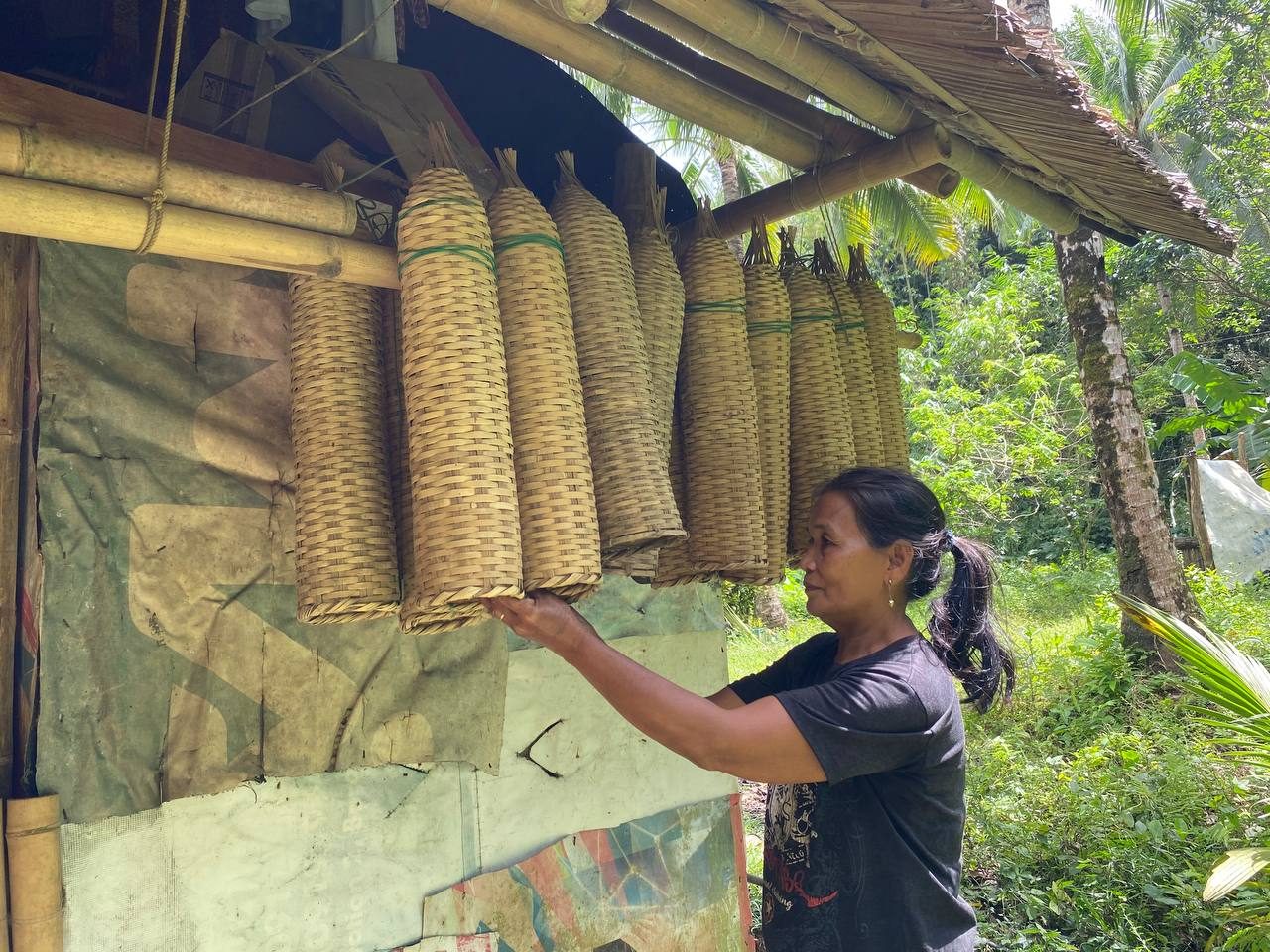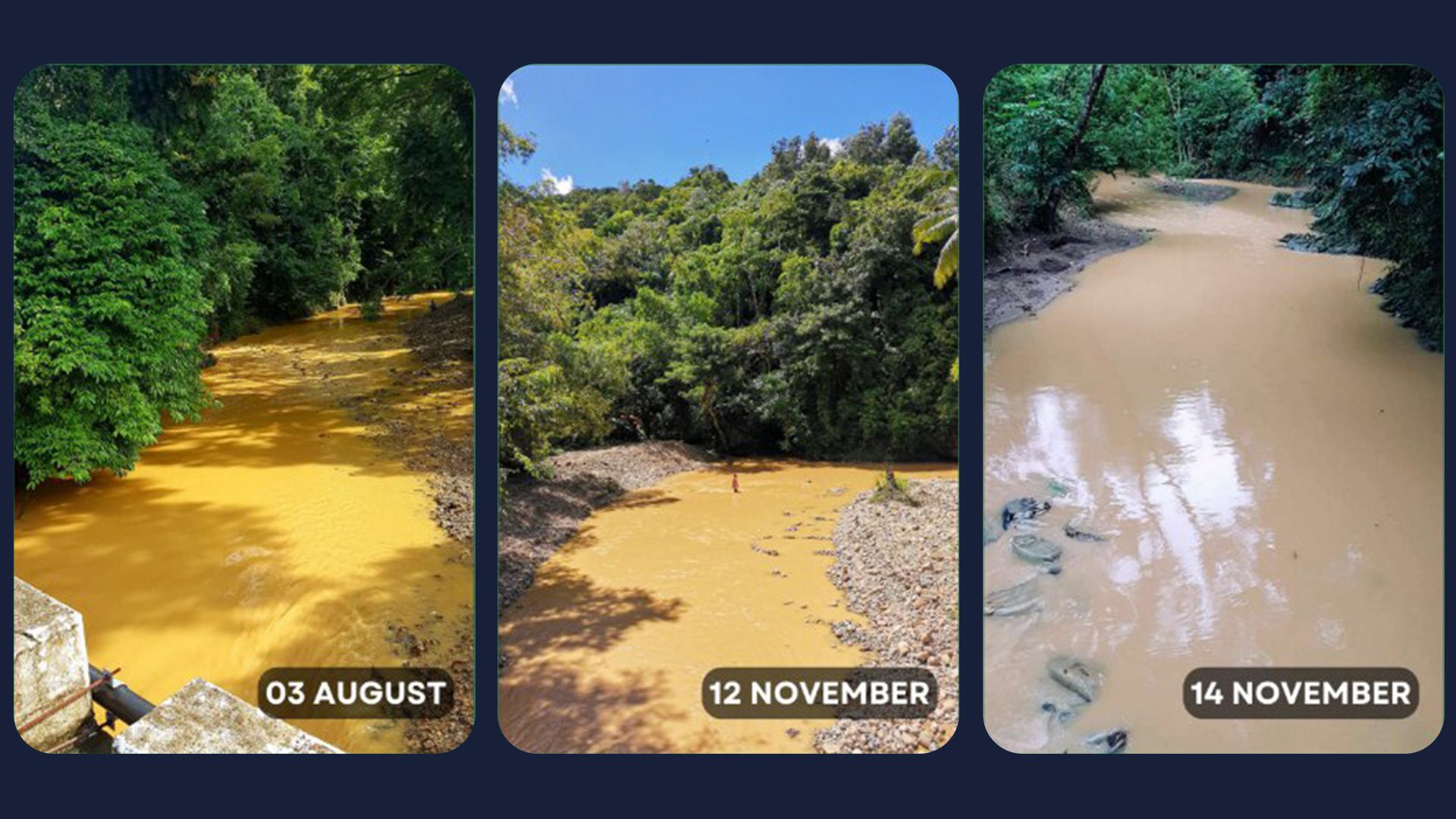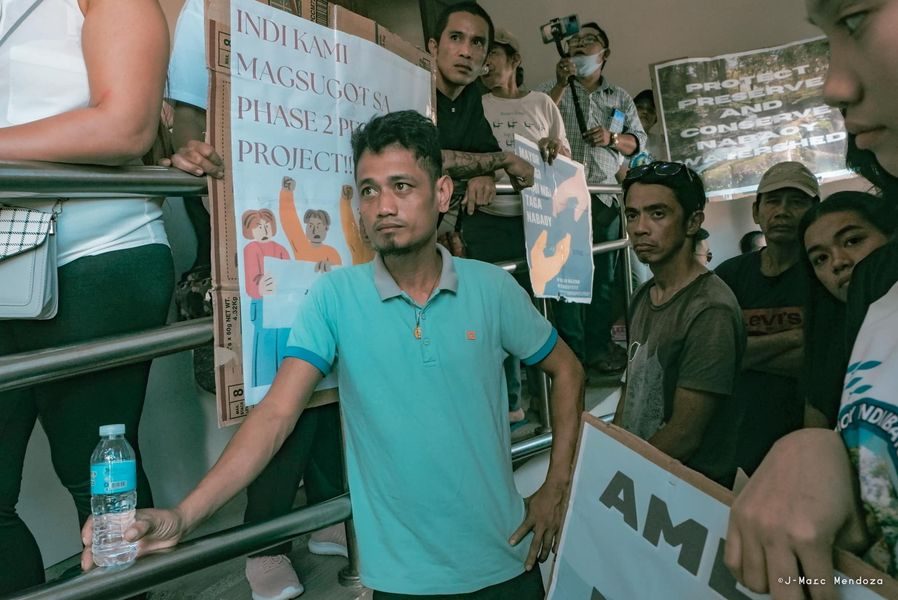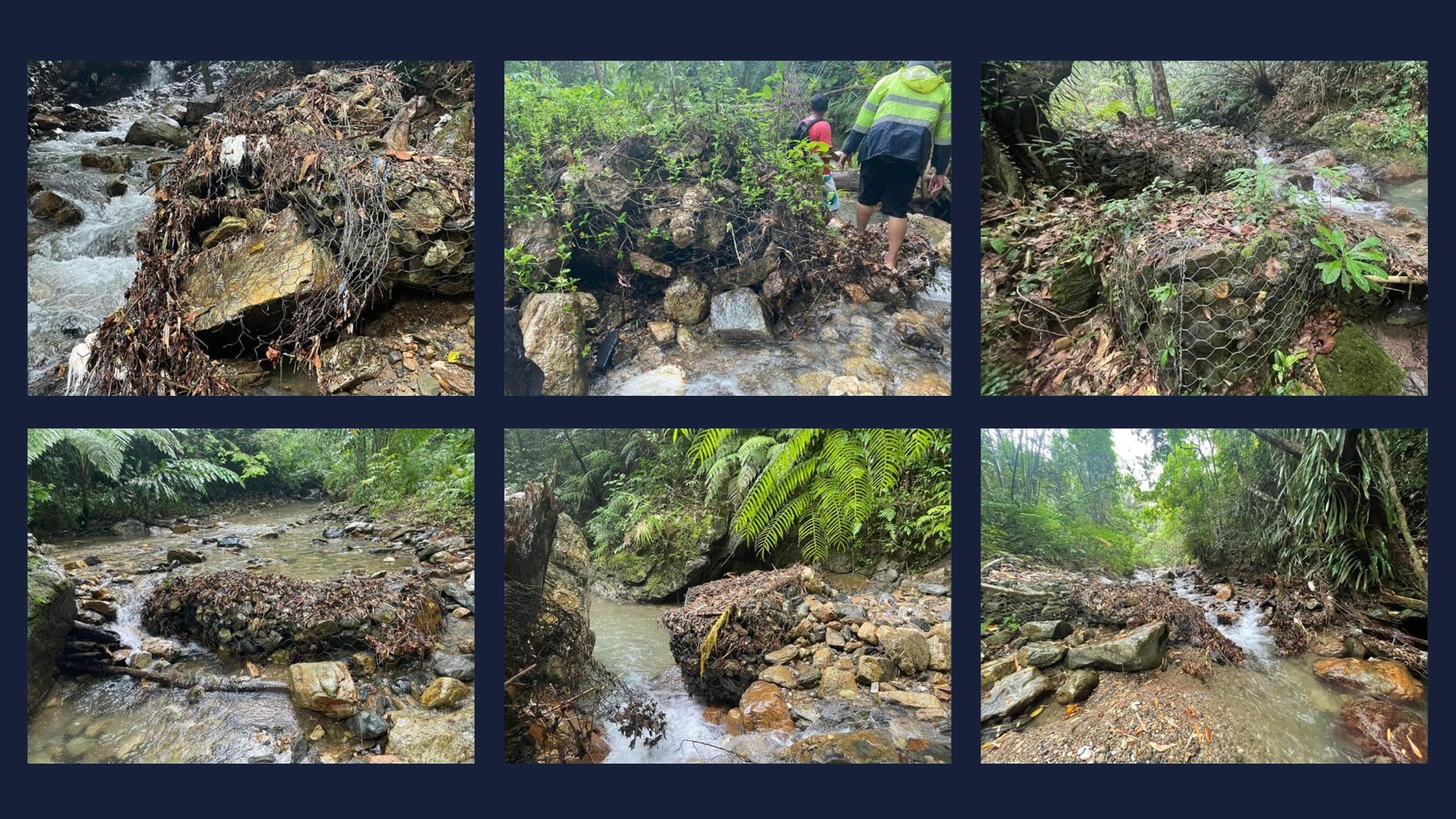SUMMARY
This is AI generated summarization, which may have errors. For context, always refer to the full article.

Before the sun rays kiss the crystal-clear waters of Nabaoy River, the soft rustle of bamboo leaves and the chirping of birds mix with the chatter of villagers.
The peace of this rural community in Malay, Aklan, however, has been disrupted by sounds of protest in recent months.
On the ground, adult residents refute the alleged benefits of a controversial windmill project that, according to them, threatens the river sustaining their village.
Online, a different battle rages for the youth who vehemently deny the false social media narratives about this renewable energy project.
Dolores Flores, 64, is one of the most affected residents. Every morning for more than 50 years, Flores, a mother of nine, has cast her traditional rattan and bamboo to catch patuyaw (native shrimp).
She can collect up to a half kilogram of patuyaw, which is then supplied to local restaurants and resorts. She earns P225 ($4) or less per day, which is not enough to make ends meet.
The problem is that her patuyaw harvest has declined over the past few years. She fears the situation will worsen due to the wind farm construction on a neighboring mountain. The nearby Napaan River, she said, “has already been affected,” and “its former beauty never came back.”
“I don’t want the same fate to befall us here in Nabaoy because our livelihood depends on the river,” Flores said.

Controversial project
Flores, along with hundreds of Nabaoynons, have called on the Malay local government unit (LGU) to stop the turbine expansion of the Nabas Wind Power Project, a renewable energy project of PetroWind Energy Incorporated (PWEI).
Vanessa Peralta, assistant vice president for corporate communication of PWEI, told Rappler that the 13.2 MW Nabas wind power project (phase two) is now supplying additional power to the Panay grid after its first three wind turbines were commissioned last April 4.
“This additional power further adds stability to the grid, especially now that demand is expected to increase due to the summer season and some power facilities, particularly hydro power plants, are affected by the dry weather,” Peralta said.
Villagers, who staged a protest last January 31, argued that the wind farm expansion project could pose irreversible damage to the Nabaoy River.
“Nabaoynons kept on saying that we won’t allow the project,” said former barangay captain Sentia Quinto, who owns Narra Resort, the longest ecotourism site along this body of water.

Quinto said Nabaoynons have reiterated to the LGU that they were not part of the project’s impact assessment, which means that Petrowind “will not be held responsible” for any harm done to the river. “What will happen to us then?” she asked.
Nabaoy River is not included in the Environmental Impact Assessment (EIA) of Petrowind’s phase two expansion project, as it is not the project’s host site. The Malay LGU, however, said that Nabaoy River is the direct impact site, because it is the river which will be hit by mud coming from the mountains where the turbines will be erected.
Even if the Malay LGU endorsed the project at first, it eventually found out that the construction resulted in heavy siltation in Napaan River. This prompted the LGU to revoke its endorsement of the project’s expansion in Napaan in August 2023.
However, when asked about the damage found by the Malay LGU, Peralta said that “PWEI is fully compliant” as the Department of Environment and National Resources (DENR) released two reports disproving the allegations of critics.
Peralta said that the DENR reports – based on multiple inspections, as opposed to the critics’ one-time audit hike – confirm that the project complies with environmental laws and that Petrowind followed rules and guidelines on engaging stakeholders. She said the company has also employed effective measures to prevent negative effects on nearby rivers.
Costs and benefits
Villagers remain unconvinced about the benefits of the project, even if Petrowind promised a corporate social responsibility program – which the Malay LGU adopted on February 22 despite having no public consultation on it.
“They only did that now because many have been complaining,” Quinto said. “Petrowind has no concrete plans for us in the first place, because if there are, we should be included in their EIA.”
She was also enraged when Nabas Wind Farm reportedly posted on Facebook that they have conducted a public consultation with Nabaoynons. Quinto said it never happened. The local community also denied the post, saying that it was a meeting of Pawa, Napaan, Nabaoy Forest Developers Association (PANANAFODA), which does not concern Nabaoy as a whole.
“They merely took photos of us on the table, but there’s no [public consultation],” Nabaoy barangay captain Nolasco Claud told a provincial investigation committee, as seen in a video obtained by Rappler. “What they presented here were lies. That’s why we’re here, seeking help because our municipal officials in Malay didn’t hear us.”
Meanwhile, youth from Nabaoy have also encountered the same challenges in the online sphere.
“They block people who comment on their posts. They deleted our comments opposing them. This is their way of preventing people from knowing that they are spreading fake news,” said Stefhanie Bernabe, Sangguniang Kabataan kagawad of Nabaoy.
Bernabe said that since social media has become the primary source of information, Petrowind has been spreading disinformation online, confusing those who seek updates on Nabaoy River. According to her, based on the comments they read, many are manipulated through deceptive posts and fake narratives shared on social platforms.
In return, the SK Council also created a Facebook page, Nabaoy Environmental Defenders, to combat disinformation posted by Petrowind online.
“To defend ourselves, we shared evidence proving that the things said on social media were incorrect. We listened to the locals’ opinions directly. We talked to credible individuals for statements, especially those knowledgeable in environmental conservation and protection, so that others will know how precious our river is and what we are going through here,” Bernabe said.
Bernabe also said that they are constantly besieged by trolls and fake accounts, commenting about their support for the project.
To this, Peralta said: “That particular claim is a disinformation and we appeal to them to be more discerning and vigilant with all the information that is now circulating online. PetroWind does not promote nor tolerate disinformation and we only share factual and verified data backed by reports from regulating agencies such as the DENR.”
What’s at stake
Researchers are calling for the protection of the Nabaoy River due to its “unique ecosystem.”
In a Facebook post, Philippine Nuclear Research Institute specialist Raymond Sucgang said Nabaoy River is able to produce “pure water” that is “like purified water.” This is because the river contains a very low concentration of dissolved ions, which makes it more desirable for drinking and other uses.
“Believe me, in my 15 years of experience in hydrology studies, this is the first time I’ve encountered water of this type. It’s highly suitable as a drinking water source because it requires minimal purification. There’s no need for costly multi-treatment processes like those used in most surface water treatment plants,” he said.
Nenette Graf, former Sangguniang Bayan member of Malay and head of the committee on environment, said that they can live without power, but can’t live without water. “Boracay is a tourism hot spot in the Philippines, and it generates multimillion dollars every year. Are we insane to sacrifice it for a six-megawatt turbine?”

Local leaders in Nabaoy proposed that if the Malay government intends to proceed with the project, it should be relocated away from the rivers and mountains of the Northwest Panay Peninsula Natural Park, the last low-lying forest in Panay.
“The safest decision for LGU Malay and the Province of Aklan is to relocate the last three remaining wind turbines,” environmental advocate Ritchel Casidsid Cahilig told Rappler.
Wind Management Group and Department of Energy representative Clarita de Jesus said that relocation is possible. The stakes are high for Petrowind, however, because failure to complete the project would result in a penalty, given the Marcos administration’s aggressive push for renewable energy.
Peralta said in an interview with Kalibo Cable TV: “The relocation is not easy. Our stance here is that we have not violated any environmental rules. We are fully compliant and are following all regulations. Therefore, there are no grounds to halt or relocate the project because we are not in violation of anything.”
Despite community protests and evidence of environmental impact, Petrowind’s wind turbine expansion project will continue. “The Malay LGU has formally reendorsed phase two last February 22, 2024. We cannot speak for them, but we thank the Malay LGU for reendorsing the project,” Peralta said.
Villagers of Nabaoy are standing firm for their cherished river.
“We are not against renewable energy. That’s development,” said Vicky Aguirre, head of the municipal investigation committee looking into the project. “But we also have to ensure that it is sustainable.” – Rappler.com
*Quotes in the local language have been translated into English.
Jed Nykolle Harme is the associate editor of Aklan State University’s Eamigas Publication and the editor-in-charge of Explained PH-Aklan. She is also an Aries Rufo Journalism fellow of Rappler for 2023-2024.
Add a comment
How does this make you feel?
![[OPINION] You don’t always need a journalism degree to be a journalist](https://www.rappler.com/tachyon/2024/06/jed-harme-fellowship-essay-june-19-2024.jpg?resize=257%2C257&crop=287px%2C0px%2C720px%2C720px)









There are no comments yet. Add your comment to start the conversation.